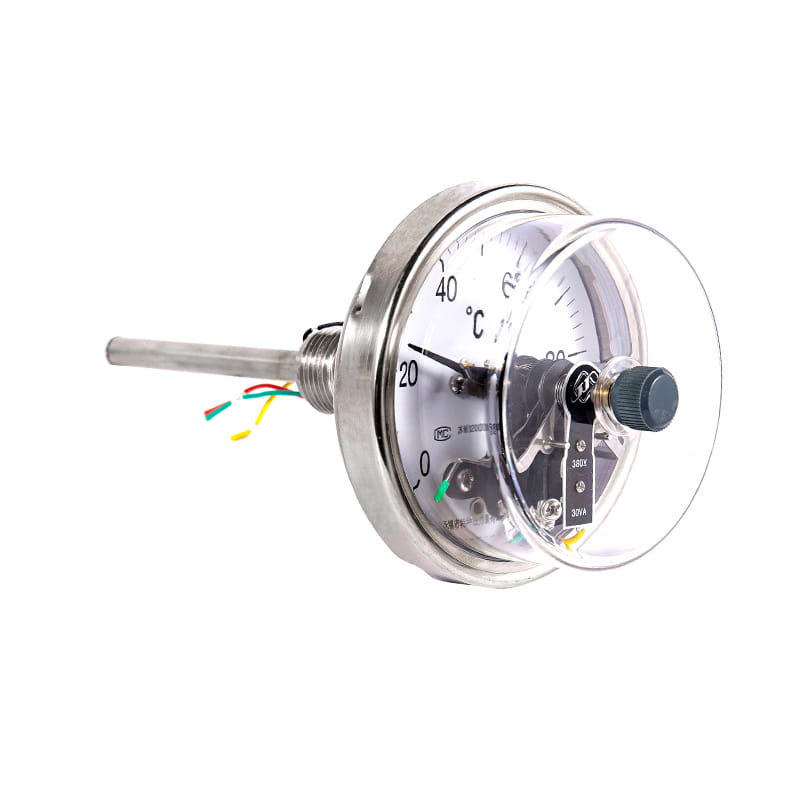YEB series stainless steel diaphragm pressure gauge
Cat:Pressure Gauge
◆ Model:YEB60 YEB100 YEB150◆ Use: This series of instruments are suitable for measuring the low micr...
See DetailsA bimetallic thermometer is a mechanical device used to measure temperature. It works on the principle that two dissimilar metals expand at different rates when exposed to heat. This differential expansion causes the metallic strip to bend or rotate, and that movement drives a pointer on a dial to indicate temperature.
Bimetallic thermometers are highly popular in industrial, commercial, and HVAC applications due to their durability, simplicity, and no-need-for-power design.
How Does a Bimetallic Thermometer Work?
At the core of a bimetallic thermometer is a strip made by bonding two different metals — typically steel and copper or steel and brass. These metals have different coefficients of thermal expansion.
When the temperature changes, one metal expands more than the other, causing the strip to bend. This bending motion is mechanically linked to a pointer on a calibrated dial. The pointer’s position corresponds to the current temperature.
There are two main construction forms:
Helical (spiral) bimetal strip: For circular dial thermometers.
Straight bimetal strip: Used in simple temperature-sensing applications.
What Are the Advantages of Bimetallic Thermometers?
Bimetallic thermometers offer a wide range of benefits, making them suitable for a variety of use cases:
1. No Power Supply Required
They are purely mechanical devices, which makes them ideal for remote or hazardous environments where electricity is unavailable or unsafe.
2. Durability
Bimetallic thermometers are often rugged and resistant to vibration, corrosion, and moisture.
3. Cost-Effective
Compared to digital or infrared thermometers, bimetallic models are much more affordable and require minimal maintenance.
4. Wide Temperature Range
They typically measure temperatures from -70°C to 600°C (-94°F to 1112°F).
5. Fast Response Time
When correctly installed, they provide quick and accurate readings.
Where Are Bimetallic Thermometers Commonly Used?
These thermometers are used in many industries and applications, such as:
HVAC systems (heating, ventilation, and air conditioning)
Food processing equipment
Boilers and industrial furnaces
Refrigeration systems
Pharmaceutical and chemical manufacturing
Automotive applications
Petrochemical plants
Greenhouses and incubators
Their versatility and simplicity make them suitable for both process control and safety monitoring.
What Are the Different Types of Bimetallic Thermometers?
1. Dial Thermometers
These are the most common type. They feature a dial display (analog), and are usually available in vertical, rear, or adjustable angle designs.
2. Industrial Thermometers
Heavy-duty thermometers designed for high-pressure and high-temperature environments, often with stainless steel casings and anti-corrosion features.
3. Panel-Mounted Thermometers
These are designed to be integrated into control panels or equipment dashboards.
4. Remote Reading Thermometers
Equipped with a capillary tube to measure temperatures at a distance from the dial.

How to Choose the Right Bimetallic Thermometer?
When selecting a bimetallic thermometer, consider the following factors:
Temperature range required
Stem length and diameter
Mounting type (rear, bottom, adjustable angle)
Dial size (typically 2", 3", 4" or 6")
Accuracy requirement (usually ±1% of full scale)
Case and stem material (stainless steel is best for harsh environments)
Response time and application pressure
A properly selected thermometer ensures accuracy and long-term reliability.
Are Bimetallic Thermometers Accurate Enough?
Yes, especially for general industrial and commercial purposes. Typical accuracy ratings are:
Standard grade: ±2% of full scale
Industrial grade: ±1% of full scale
While they may not be as precise as digital sensors, they are more than adequate for processes where high precision is not critical, but reliability and durability are essential.
How to Maintain a Bimetallic Thermometer?
Maintenance is minimal, but to ensure accuracy:
Avoid overexposure to temperature extremes outside the rated range.
Clean the stem regularly if it’s used in viscous or dirty environments.
Calibrate periodically if required for quality control.
Store in a dry place to avoid rust and corrosion if not made of stainless steel.
Bimetallic Thermometer vs. Other Temperature Measuring Devices
| Feature | Bimetallic Thermometer | Digital Thermometer | Infrared Thermometer |
| Power Required | No | Yes | Yes |
| Response Time | Medium | Fast | Instant |
| Cost | Low | Medium | High |
| Durability | High | Medium | Medium |
| Environment Suitability | Harsh/Industrial | Lab/Medical | Lab/Industrial |
| Calibration Needs | Low | Medium | High |
What Are the Limitations of Bimetallic Thermometers?
Despite their advantages, they do have a few limitations:
Limited accuracy for highly sensitive applications.
Mechanical wear over time can affect performance.
Not ideal for rapid temperature fluctuations.
Not suitable for remote monitoring unless paired with sensors or transmitters.
Conclusion: Are Bimetallic Thermometers Still Relevant?
Absolutely. While electronic and digital thermometers are gaining popularity, bimetallic thermometers continue to be a staple in industries that value ruggedness, simplicity, and cost-effectiveness. Whether you're monitoring a boiler, an HVAC system, or a refrigeration unit, a bimetallic thermometer is often the most practical and durable choice.